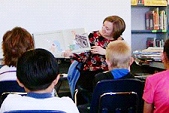Schools and Public Libraries Working Together

At a time where everyone is asked to do more with less, synergies are essential. Perhaps there's no more natural synergy waiting to be explored than a creative collaboration between public schools and public libraries.
Schools and libraries have often worked together in the past. The difference is that in a world where "no child left behind" sometimes means every child is left behind, those success stories become even more compelling. Kate Todd, recently with New York Public Library (NYPL) and now in an academic library, has worked diligently to share these stories through a webpage accessible through ALA. From there, one can jump to learn more about Multnomah County (OR) and their School Corps program, find out how commitment from the top works at Howard County in Maryland, or discover what a BLAST cooperation can be in Pittsburgh (PA).
Here are some proven strategies, gleaned from Kate Todd:
--At the beginning of the school year, public librarians in the branches should physically visit all the schools in your service area and meet the librarians. If you're in the school, do the same with your local branch.
--Start with something manageable, such as a collaboration between one school and one library branch. Once that is working, then expand it.
--Be realistic about funding. Working together doesn't usually save money but it does serve your population better and it is definitely better for kids, parents, and teachers.
--Know that it's hard to serve two masters so establish clear lines of communication and expectations up front.
During her time at NYPL, Kate and her team took an annual frustration -- teachers assigning summer reading titles that were out of date or even out of print -- and turned it into the foundation for a fruitful collaboration that expanded well beyond the initial challenge.
The public librarians took the initiative to create a list based on what they had in their collections that fit the needs of summer reading. They then distributed it to the schools. Teachers began to count on them and the school librarians requested the opportunity for input. They joined the annual meeting where the list was created and all joined together in marketing the list. "School librarians didn't have as much access to new books," recalls Todd, "so we held the meetings in the Central Library and the school librarians could get to know the books." From a problem, summer reading became a cooperative activity with a city-wide kickoff and media coverage. Perhaps best of all, even though the originators of the program have moved on, it has taken on a life of its own.
Accelerated Reader and other reading programs can present a similar challenge/opportunity. Todd points to King County in Washington as another success story. The public library built an online database of all the quizzes for each school including their reading and point levels. The library relies on the school to give them their lists but parents have become their best advocates in encouraging cooperation.
At the Carnegie Public Library in Pittsburgh, Georgene DeFilippo structured a program that places certified reading specialists within the public library system. Now in its seventh year, BLAST has proven very effective and popular with teachers, librarians, and students. DeFilippo drew on resources in her area and most especially Dr. Rita Bean of the University of Pittsburgh. Using best practices and information from workshops and journals, the program has changed over time to reflect not only fiction but also informational texts. "My staff is mirroring what the classroom is doing," remarks DeFilippo.
Among the BLAST programs is a third grade interactive read aloud program that is very structured. Partner schools are selected based on factors including those needing extra literacy education. "It's good to be working with third grade because they have language and world experiences needed to enable us to make it a richer discussion," explains DeFilippo. BLAST specialist Laura Bandura agrees. "Teachers have told me that they have had kids respond to blast books in a way they have never done before—that now they read for the sake of reading."
"It's a real literacy program, not just storytime," confirms Bandura. "We provide picture books to the schools, we select the titles, and we select books that promote discussion with strong messages and diversity." Henry's Freedom Box by Ellen Levine, Comets, Stars, the Moon and Mars, a book of space poetry by Douglas Florian, and Kelly DiPucchio's Grace for President are some recent favorites. "Ahead of time, the blast staff decides what questions to ask and settles on two vocabulary words," explains Bandura. "We provide each child with a blank journal at the beginning of the school year and there's a writing activity that goes with each book." BLAST provides a copy of the book to each classroom and to the school library. At the end of the year, BLAST joint sponsors a field trip to the library.
Seven years of inspiring children to open a book not because they have to, but because they want to. The fruits of public library and public school cooperation are sweet.
To find out more, visit the AASL/ALSC/YALSA Interdivisional Committee on School/Public Library Cooperation at http://www.ala.org/ala/mgrps/divs/alsc/alscresources/forlibrarians/schplcoopactivities.cfm and visit Kate Todd's website "Together: Librarians and Teachers as Education Partners" at http://www.edukatetodd.com/cooperation/.
